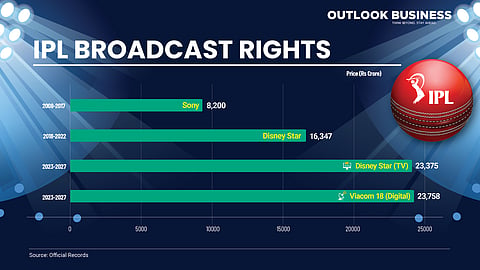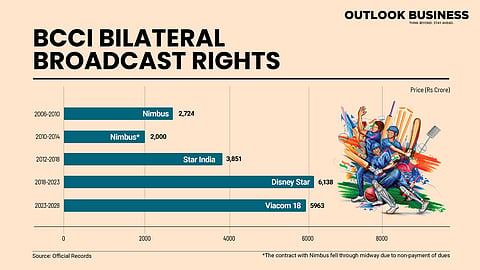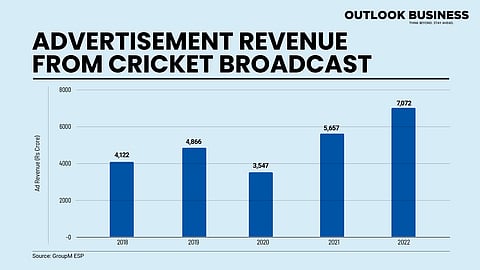2023 is a big year for the Board of Control for Cricket in India (BCCI), the world’s richest cricket board. India is set to host ICC Cricket World Cup in October for which the preparations are in full swing. While the attention on the biggest cricketing event is expected to bring significant revenue for the board, it has also recently concluded the sale of broadcasting rights for India’s home matches to Viacom18 for Rs 5,963 crore.
Why Cricket Broadcasting Rights Remain A Winner's Curse In India
The valuation of the cricket business in India has shot up over the past few years. While this has made the Board of Control for Cricket in India (BCCI) the wealthiest cricket board in the world, broadcasters are struggling to find profitable revenue streams due to the soaring price of media rights
From a cash-strapped agency that did not have money to gift to its men who had returned home as the World Cup champions in 1983, the BCCI has come a long way as it reaped the benefits of the craze for the sport in the country. In financial year 2008, the cricket body had reported a surplus income of Rs 303 crore. By fiscal 2022, this had reached Rs 2,691 crore.
The main reason behind BCCI’s financial rise has been the skyrocketing valuations of its media rights. In a country that treats cricket as a religion, cricket content allows broadcasters to reach a very wide market. However, while BCCI has been able to capitalise on the market, the same cannot be said for the broadcasters who often struggle to break even. The dilemma is worse for those who can neither take nor leave the deal without feeling the heat.
BCCI Cashes In
The BCCI added several feathers to its cap over the past few years: the national men’s team won two world cups and several new cricketing icons took strike, but it was the launch of the Indian Premier League (IPL) that took the cake. With the kind of attention that it garnered, IPL changed the fortunes of BCCI, elevating it to the position of the most powerful cricket board globally. In 2022, IPL’s earnings from central sponsorships crossed Rs 1,000 crore, according to reports. Between 2008 and 2023, the IPL’s annualised media rights cost went from Rs 820 crore to Rs 4,839 crore, growing at 33 per cent annually.

“Cricket is primarily treated as a unique property in India. The way it helps capture audience, broadcasters like to try and capture the monopolistic opportunity around it,” says Raman Raheja, co-owner of Legends League Cricket which features retired cricket players.
Not only IPL, the bilateral matches of Indian teams have also added to the fortunes of BCCI. For bilateral matches hosted by the BCCI, the annualised price for broadcasting went from Rs 681 crore in 2008 to Rs 1,227 crore in 2023.
The trend of super high valuation for the board began in 2006, a year cited as a turning point for cricket broadcasting. BCCI made its biggest kill until then by selling the media rights for the 2006–10 season at a previously unheard price of Rs 2,724 crore to Nimbus Communications, owned by Harish Thawani. For comparison, state-backed Doordarshan had made a bid of Rs 250 crore for the BCCI rights between 1999 and 2004.

The bid by Nimbus was a decisive moment in the cricket broadcast history of India. “I think that is when we realised that the media is also changing in a big way,” says Nikhil Vyas, founding partner of ITW Universe, a sports media services firm.
In the rights sales of following years as well, BCCI found takers for media rights at high prices. However, the skyrocketing valuations had serious consequences on business of the broadcasters.
Star Cracks The Game
When the rights sale happened in 2010, Nimbus found it hard to justify the price tag of its previous lucrative purchase and the company reduced the price to Rs 2,000 crore. Due to Nimbus’ financial troubles, BCCI nullified its contract with the broadcaster midway. At that point, India had just won the 2011 World Cup and the cricket frenzy in the country was at a fever pitch.
Star India, owned by media mogul Rupert Murdoch, stepped in to sweep up the rights for BCCI’s bilateral matches for the next six years at Rs 3,851 crore. For Star, a popular asset like cricket could help it cross-sell many of its other offerings.
“Back then, a broadcaster could go to its distributors and tell them that there is a bundle of 40 channels, out of which some channels will telecast IPL or BCCI cricket. This used to give them a drive on subscription revenue,” says Rajesh Sethi, former head of Ten Sports and NBA India.
Primarily, there are three revenue sources for broadcasters: subscription, ad sales and syndication. There is consensus within the sports media industry that advertisements form the majority of revenue for cricket broadcasters.
Raheja believes that the revenue from advertising alone was sufficient for Star to cover the acquisition costs of its cricket properties before 2018. The data from Media Partners Asia further shows that Star India’s television ad sales revenue rose almost five times from Rs 1,526.8 crore in FY10 to Rs 7,482 crore in FY18. Its digital property Hotstar also brought in Rs 568 crore ad revenue in FY2018.
By the end of FY18, Star was the second largest media network in India, and it closed FY2018 with a profit of Rs 287.7 crore. But things were about to change for Star India, and the broader sports broadcasting industry in the country, due to regulatory changes by the Telecom Authority of India (TRAI) and consumer preferences leaning towards the digital.
Broadcaster’s Bane
After having acquired IPL and other cricket properties at high prices, Star India was taken over by global media major Walt Disney company in 2019 for $71.3 billion. The network also slipped into the red, posting a loss of Rs 1,216 crore in FY2019.
The IPL media costs for 2018–22 alone were Rs 16,347.5 crore. The annualised rate was Rs 3,269.5 crore, more than four times the price Sony Pictures Network India paid for the initial 10 seasons of the IPL. After losing the IPL rights, NP Singh, managing director and CEO of Sony, had said that his network became larger and more profitable since parting ways with the IPL. Industry executives were sceptical whether Star would be able to break even with all the investments it had made in cricket assets.
“In most markets, including India, sports broadcast is viewed as a loss leader. But as a network, it allows you to create a much bigger impact by building a lot around it and cross-selling other properties,” says Mihir Shah, vice president and head of Media Partners Asia (MPA) for India.
But by 2019, the idea of cross-selling other products on linear TV took a regulatory hit when TRAI allowed consumers to select and pay only for the channels, they wanted instead of subscribing to bigger packages offered by broadcast networks.
Around the same time, cord cutting—users cancelling subscriptions to multi-channel television services—started becoming an increased phenomenon across India. As per the FICCI-EY 2023 report, TV subscription revenue has been falling for three straight years now and has hit degrowth.
Data shows that between 2019 and 2022, Disney Star shelled out Rs 6,114 crore every year for broadcasting BCCI bilateral, IPL and ICC events across its linear TV and digital platform. The average annual ad revenue across the entirety of India’s cricket market in this period was not more than Rs 5,000 crore.

Given this background, are the skyrocketing valuations justified? Raheja does not think so. He says, “The way the valuation has leapfrogged in the recent past, it is just not justifiable.” On top of the pressure on TV subscription revenue, broadcasters are also grappling with Ambani’s big gamble on streaming business which has changed the game.
The Blow of Digital Freebies
Viacom 18’s entry into IPL broadcasting changed the game for digital and TV broadcasters. While Disney+Hotstar was relying on a combination of ad and subscription revenue to stream cricket digitally, Ambani-backed JioCinema decided to stream the lucrative IPL for free in 2023, disrupting a sector that is already facing the pressure of soaring valuations. The gamble to broadcast the tournament for free helped it reach over 44 crore viewers during the tournament.
“Cricket was predominantly watched on television. It was Hotstar which came in and changed the game. It had been monetising it through a subscription model. But then, JioCinema came in, decided to go for mass reach and impact and offered free viewing of cricket,” adds Shah.
Loss of IPL streaming rights to Viacom18’s JioCinema app meant that the value of Disney Star’s digital platform took a hit. Since the streaming of the first IPL 2023 match on JioCinema until now, Disney+Hotstar has lost 24 per cent of its subscription base.
After JioCinema’s success with the free IPL broadcast, Disney+Hotstar also ended up deciding that it will stream Asia Cup and ICC Men’s Cricket World Cup 2023 for free this year. The decision of Viacom18 to stream for free was a blow to the plans of monetisation of digital cricket broadcast via subscriptions. In addition to concerns around cord-cutting and the free digital streaming model, a challenging ad market could also add to broadcaster’s woes now.
The Next Innings
The ad market for cricket in India showed some promise for broadcasters in 2021-22. But the industry fears that the increased ad spending on cricket content may not continue now.
In the ICC T20 World Cup 2022, three out of the top 10 advertisers were start-ups from the real money gaming (RMG) sector: Dream11, My11Circle, A23 Poker. The recent change in GST regulation for RMG apps is expected to force these companies to minimise their marketing expenditure.
“What we saw in the last two years or so is possibly an anomaly that was caused by venture capital backed growth chasing start-ups. Now that the money has been drained out and P&L oriented companies are back on the leaderboard of top spenders, we are arriving at the actual real valuation [of ad market],” says Vyas of ITW Universe.
BCCI, too, has acknowledged that the marketing expenses of many spendthrift companies are coming down in the market. Earlier this year, while putting up the jersey rights for team India matches for sale, the governing body set a base price of Rs 3 crore per match, much lesser than the Rs 5.07 crore paid by edtech start-up Byju’s earlier.
For conventional broadcasters, there are headwinds in the form of adverse ad market, falling TV subscription revenue and market-enforced forfeiture of subscription revenue from digital streaming.
Going forward, striking a fair balance between the price of TV and digital rights may end up pushing out players without deep pockets. Vyas says, “BCCI is doing a fine job at getting strong traction from the private media houses in getting such high valuations for their properties. Now, it all comes down to the broadcasters to figure out a way to create more revenue streams to avoid the winner’s curse. Currently, the format of revenue generation is clearly not working in their favour and is not sustainable in long term.”
For broadcasters, despite the headwinds, cricket-related business is too big to be ignored in the Indian market. There is always the allure of attaining both digital and TV rights to achieve a monopoly on the cricket show business. If broadcasters can come together for linear-linear or linear-digital partnerships, it will help them save acquisition costs. Such practices are already prevalent in more mature sports markets like the US.
With a far-sighted design, broadcasters can possibly monetise cricket content better in the world’s largest market for the game. Until then, they will have to accommodate the harsh demands of India’s cricket market even as the BCCI continues to make its way to big bucks.